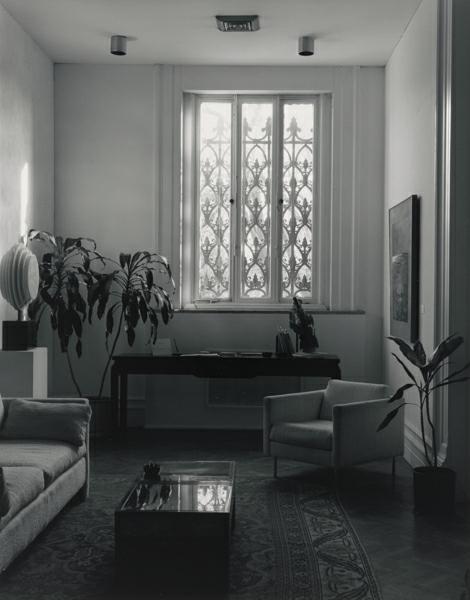Corcoran as HOME
Paul Kennedy (b. 1944)
Photographs from “Portfolio of Photographs of the Corcoran,” 1973
Gelatin silver print
Gift from the Trustees of the Corcoran Gallery of Art (Museum Purchase)
Paul J. Kennedy was a faculty member of the Corcoran College of the Arts and Design from 1971 to 1974. On March 12, 1973, in a letter to Roy Slade—the Dean and Director—Kennedy requested to create a portfolio for the school:
I propose to photograph the Corcoran [Gallery of Art] not as a building where art is displayed but as a piece of art in itself. By photographically exploring every floor and room only then will we be able to see the total beauty of this building we call the Corcoran.
The commission resulted in sixteen photographs that documented the beauty of the building. The Beaux-Arts style building was designed by Ernest Flagg in 1897, and Kennedy’s photographs successfully present the building as a regal home for the Corcoran Gallery and the school. The Flagg Building has remained a binding identity for the Corcoran School even through its recent acquisition by the George Washington University.
Member’s Lounge, Corcoran Gallery of Art
The Member’s Lounge was a room in front of the Atrium and Grand Staircase. Members of the Corcoran Gallery could engage in conversation and rest in this lounge space. The intimate space with chairs and a coffee table created a comfortable atmosphere where sunlight poured in from the large windows facing 17th Street. The lounge provided a home-like space in the Gallery, isolated from the outside world.
Little Mantle Room, Corcoran Gallery of Art and Little Mantle, Corcoran Gallery of Art
Located on the first floor of the building behind the original gallery spaces the Little Mantle Room was built with a fireplace, large windows, wall decorations, and a high ceiling. Although not luxurious, the room functioned as a passage to the Salon Doré and emanated a feeling of homey warmth through the Beaux-Arts style fireplace and the large windows as visitors traverse to the opulence presented in the Salon Doré.
Salon Doré, Corcoran Gallery of Art
The Salon Doré is a Louis XVI paneled room designed by the architect Jean-François-Thérèse Chalgrin in 1770 and was originally installed at the Hôtel de Clermont, which was a private residence in Paris. The panels were eventually sold to Senator William A. Clark to be displayed in his New York mansion. Upon Clark’s death in 1925, the room was relocated to its current position in the Flagg Building. Kennedy’s photograph of the Salon Doré was taken before the room underwent extensive preservation in 1990, yet Kennedy portrays the natural luminescence of the room’s precious materials, including the intricate moldings and gold leafed trophy panels. It is interesting to note that this room—originally intended for a private hôtel particulier—was incorporated into the Corcoran and became an important part of the identity of the Corcoran Gallery of Art and the Corcoran School.
Jacob Gayer (1884-1969) Rotunda of the Corcoran Gallery of Art, Washington, D.C., 1928; printed 1987 Dye transfer print
Gift from the Trustees of the Corcoran Gallery of Art (Gift of Eastman Kodak Company)
Originally published in the National Geographic article “Unique Gifts of Washington to the Nation,” Jacob Gayer, a staff reporter and photographer for the magazine, chose to use the autochrome process with this photograph – a revolutionary, portable medium that allowed photographers to capture color “on the go” – popular from its commercial debut in 1907. The photograph depicts a woman seated in the rotunda of the Corcoran Gallery of Art, surrounded by works from the recently gifted William A. Clark Collection. In the original caption for the photograph, Gayer notes that Washington was gradually becoming a national center, or home, for the arts, the Corcoran Gallery of Art being the premier institution.
A home to the arts in Washington for over 140 years, the Corcoran closed in 2014, removing all of the works from their home at the Corcoran. While the works in the image have found new homes, this photograph remains a witness to the stage in their life when they called the Corcoran home.
Works pictured in the photograph (from left to right):
- Charles Renaud, Prometheus Attacked by the Eagle, n.d. National Gallery of Art, Washington
- School of Perugino, Madonna and Child with Two Angels, Saint Rose, and Saint Catherine of Alexandria, early 16th century, National Gallery of Art, Washington
- After Antonio Canova, Venus, carved 1822/23, National Gallery of Art, Washington
- Titian, Martino Pasqualigo, 1546, American University Museum, Washington
- Thomas Gainsborough, Frances Susanna, Lady de Dunstanville, 1786, National Gallery of Art, Washington
- Rembrandt van Rijn, Man with a Sheet of Music, 1633, National Gallery of Art, Washington
HOME: Selections from the Corcoran Study Collection






